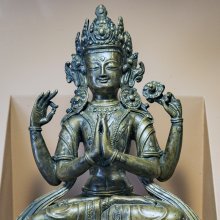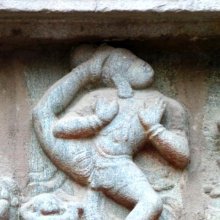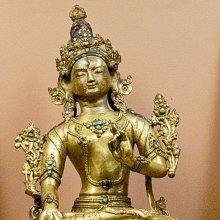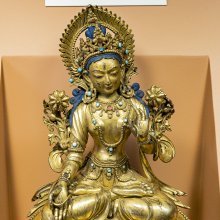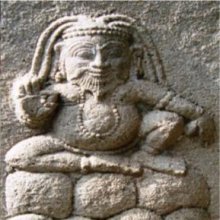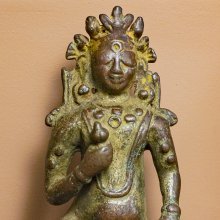Forehead: 3 definitions
Introduction:
Forehead means something in Hinduism, Sanskrit. If you want to know the exact meaning, history, etymology or English translation of this term then check out the descriptions on this page. Add your comment or reference to a book if you want to contribute to this summary article.
Images (photo gallery)
(+15 more images available)
In Hinduism
Yoga (school of philosophy)
Source: ORA: Amanaska (king of all yogas): A Critical Edition and Annotated Translation by Jason BirchForehead (meditation) (i.e., ‘meditating on the forehead and brow’) forms part of the various Teachings or Techniques (saṅketa) on Layayoga, according to the Dattātreyayogaśāstra verse 21-26.—Note: The Dattātreyayogaśāstra’s techniques (saṅketa) of Layayoga can be summarised as meditation on the void, gazing on the tip of the nose, meditating on the back of the head, gazing between the eyebrows, meditating on the forehead and brow, meditating on the two big toes and lying on the ground like a corpse.

Yoga is originally considered a branch of Hindu philosophy (astika), but both ancient and modern Yoga combine the physical, mental and spiritual. Yoga teaches various physical techniques also known as āsanas (postures), used for various purposes (eg., meditation, contemplation, relaxation).
Gitashastra (science of music)
Source: Shodhganga: Elements of Art and Architecture in the Trtiyakhanda of the Visnudharmottarapurana (gita)The Forehead (in Sanskrit: Mūrdha) refers to one of various Organs of Utterance (sthāna), according to Bhattojidīkṣita in his Siddhāntakaumudī.—During the practise of Vocal Music, the proper production of the concerned sound is always considered as very important. Sthāna or ucchāraṇasthāna is the place of articulation of sound. Bhattojidīkṣita in his Siddhāntakaumudī said about ten kinds of sthāna (i.e., the organs of utterance), e.g., mūrdha (forehead).
Gitashastra (गीतशास्त्र, gītaśāstra) refers to the ancient Indian science of Music (gita or samgita), which is traditionally divided in Vocal music, Instrumental music and Dance (under the jurisdiction of music). The different elements and technical terms are explained in a wide range of (often Sanskrit) literature.
Shilpashastra (iconography)
Source: Shodhganga: Elements of Art and Architecture in the Trtiyakhanda of the Visnudharmottarapurana (shilpa)The Forehead is denoted by the Sanskrit term Lalāṭa, and represents one of the various body parts whose Measurements should follow the principles of ancient Indian Painting (citra), according to the Viṣṇudharmottarapurāṇa, an ancient Sanskrit text which (being encyclopedic in nature) deals with a variety of cultural topics such as arts, architecture, music, grammar and astronomy.—In the third part of the Viṣṇudharmottarapurāṇa, chapters 35th to 43rd are dedicated to the Painting of different portraits of different kinds of men and women. The measurement of almost all the body parts that should be maintained in a picture have been presented here. For example, the Forehead (lalāṭa) should be 12 aṅgulas.

Shilpashastra (शिल्पशास्त्र, śilpaśāstra) represents the ancient Indian science (shastra) of creative arts (shilpa) such as sculpture, iconography and painting. Closely related to Vastushastra (architecture), they often share the same literature.
See also (Relevant definitions)
Full-text (+1228): Lalata, Tilaka, Tripundra, Bhala, Lalatika, Visesaka, Lalamaka, Godhi, Nitala, Bhramaralaka, Laka, Kunkuma, Pundra, Alika, Shankhacari, Lalatapatta, Lalatula, Sinduratilaka, Uccalalata, Kapalapatti.
Relevant text
Search found 229 books and stories containing Forehead; (plurals include: Foreheads). You can also click to the full overview containing English textual excerpts. Below are direct links for the most relevant articles:
The Skanda Purana (by G. V. Tagare)
Chapter 2 - The Application of Tripuṇḍra < [Section 5 - Mārgaśīrṣa-māhātmya]
Chapter 15 - Brahmā Prepares to Eulogize Śiva < [Section 3b - Arunācala-khaṇḍa (Uttarārdha)]
Chapter 3 - Imprinting Marks of Conch etc. < [Section 5 - Mārgaśīrṣa-māhātmya]
Chaitanya Bhagavata (by Bhumipati Dāsa)
Verse 1.15.8 < [Chapter 15 - Marriage with Śrī Viṣṇupriyā]
Verse 2.17.19 < [Chapter 17 - The Lord’s Wandering Throughout Navadvīpa and Descriptions of the Devotees’ Glories]
Verse 2.13.95 < [Chapter 13 - The Deliverance of Jagāi and Mādhāi]
The Padma Purana (by N.A. Deshpande)
Chapter 225 - The Efficacy of Ūrdhvapuṇḍra < [Section 6 - Uttara-Khaṇḍa (Concluding Section)]
Chapter 79 - Do’s and Don’t’s for a Devotee of Viṣṇu < [Section 5 - Pātāla-Khaṇḍa (Section on the Nether World)]
Chapter 224 - Bearing the Marks of a Disc etc. Essential for a Brāhmaṇa < [Section 6 - Uttara-Khaṇḍa (Concluding Section)]
Trishashti Shalaka Purusha Caritra (by Helen M. Johnson)
Part 9: Description of Airāvaṇa < [Chapter III]
Part 1: Initiation of Kṛṣṇa at Dvārakā < [Chapter VIII - The episode of Sāgaracandra]
Part 3: Personal description of of Ajita and Sagara < [Chapter III - The initiation and omniscience of Ajita]
The Devi Bhagavata Purana (by Swami Vijñanananda)
Chapter 15 - On the rules of using the Tripuṇḍra and Ūrdhapuṇḍra marks < [Book 11]
Chapter 9 - On the rules of Śirovrata < [Book 11]
Chapter 12 - On the greatness in holding the Tripuṇḍra and Bhaṣma < [Book 11]
Garga Samhita (English) (by Danavir Goswami)
Verses 1.10.18-19 < [Chapter 10 - Description of the Birth of Lord Balarāma]
Verse 2.20.11 < [Chapter 20 - The Rāsa-dance Pastime]
Verse 1.13.17 < [Chapter 13 - The Liberation of Pūtanā]
Related products
